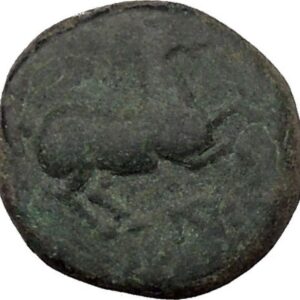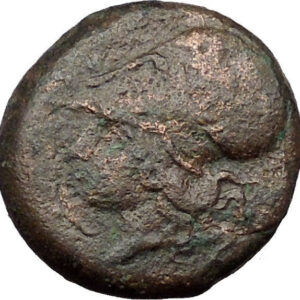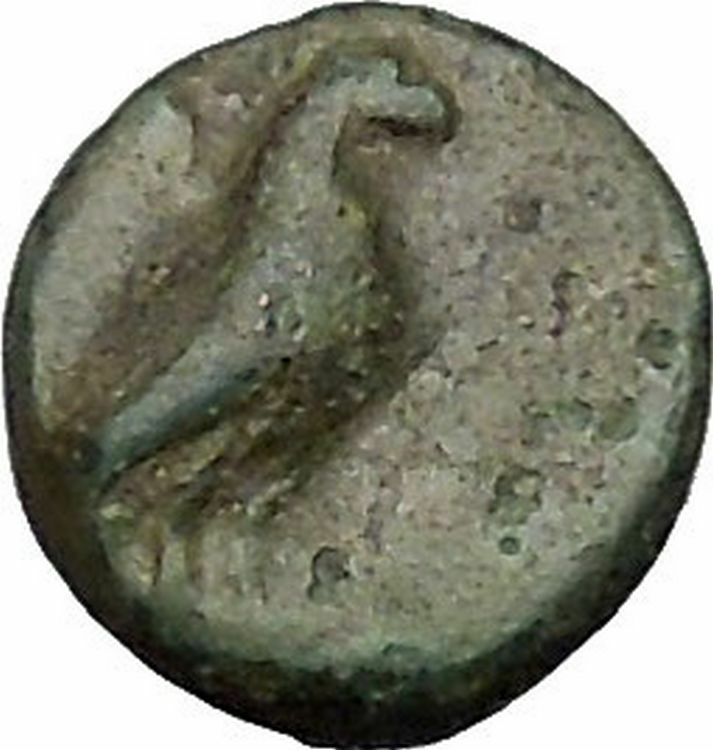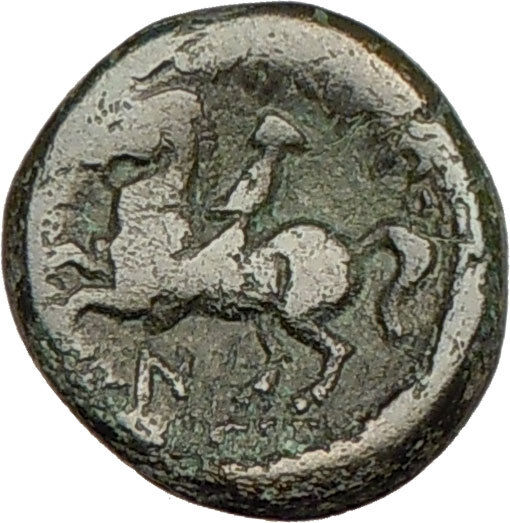|
Greek city of Leontini in Sicily
Bronze Trias 13mm (1.30 grams) Struck 430-422 B.C.
Reference: Sear 1118; B.M.C. 2.56
ΛEON, Laureate head of Apollo right; behind,
laurel-leaf with berry.
Tripod-lebes between two corn-grains; in exergue, three pellets.
Founded by Chalkidians from Naxos in 729 B.C., Leontinoi produced no coinage in
the Archaic period. In the early part of the 5th Century B.C. the city was
under the rule of the Gelan and the Syracusan tyrants, but in 466 B.C. it
regained its independence. Enjoyed considerable prosperity until 422 B.C. when
it was reduced to a state of dependency on Syracuse.
You are bidding on the exact
item pictured, provided with a Certificate of Authenticity and Lifetime
Guarantee of Authenticity.
A sacrificial tripod is a three-legged piece of religious furniture
used for offerings or other ritual procedures. As a seat or stand, the
tripod
is the most stable furniture
construction for uneven ground, hence its use is universal and ancient. It is
particularly associated with
Apollo
and the
Delphic oracle
in
ancient Greece
, and the word “tripod” comes
from the Greek meaning “three-footed.”

Apollo and
Heracles
struggle for the Delphic
tripod (Attic
black-figure
hydria
, c. 520 BC)
Ancient Greece
The most famous tripod of ancient Greece was the
Delphic
tripod from which the
Pythian priestess
took her seat to deliver the
oracles
of the deity. The seat was formed by a
circular slab on the top of the tripod, on which a branch of
laurel
was deposited when it was unoccupied by
the priestess. In this sense, by Classical times the tripod was sacred to
Apollo
. The
mytheme
of
Heracles
contesting with Apollo for the tripod
appears in vase-paintings older than the oldest written literature. The oracle
originally may have been related to the primal deity, the Earth.
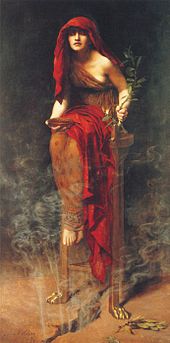
Priestess of Delphi (1891), as imagined by
John Collier
; the Pythia is
inspired by
pneuma
rising from below as she
sits on a tripod
Another well-known tripod in Delphi was the
Plataean Tripod
; it was made from a tenth part
of the spoils taken from the
Persian
army after the
Battle of Plataea
. This consisted of a golden
basin, supported by a
bronze
serpent
with three heads (or three serpents
intertwined), with a list of the states that had taken part in the war inscribed
on the coils of the serpent. The golden bowl was carried off by the
Phocians
during the
Third Sacred War
(356–346 BC); the stand was
removed by the emperor
Constantine
to
Constantinople
in 324, where in modern
Istanbul
it still can be seen in the
hippodrome
, the Atmeydanı, although in
damaged condition: the heads of the serpents have disappeared, however one is
now on display at the nearby Istanbul Archaeology Museums. The inscription,
however, has been restored almost entirely. Such tripods usually had three
ears (rings which served as handles) and frequently had a central upright as
support in addition to the three legs.
Tripods frequently are mentioned by
Homer
as prizes in
athletic games
and as complimentary gifts; in
later times, highly decorated and bearing inscriptions, they served the same
purpose. They also were used as dedicatory
offerings
to the deities, and in the dramatic
contests at the Dionysia
the victorious
choregus
(a wealthy citizen who bore the
expense of equipping and training the chorus) received a crown and a tripod. He
would either dedicate the tripod to some deity or set it upon the top of a
marble structure erected in the form of a small circular temple in a street in
Athens
, called the street of tripods,
from the large number of memorials of this kind. One of these, the
Choragic Monument of Lysicrates
, erected by him
to commemorate his victory in a dramatic contest in 335 BC, still stands. The
form of the victory tripod, now missing from the top of the Lysicrates monument,
has been rendered variously by scholars since the 18th century.
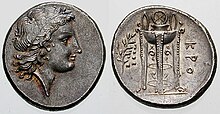
An ancient Greek coin c. 330-300 BC. Laureate head of Apollo (left)
and ornate tripod (right).
Martin L. West
writes that the sibyl at Delphi
shows many traits of
shamanistic
practices, likely inherited or
influenced from Central Asian practices. He cites her sitting in a cauldron on a
tripod, while making her prophecies, her being in an ecstatic trance state,
similar to shamans, and her utterings, unintelligible.
According to Herodotus (The Histories, I.144), the victory tripods were not
to be taken from the temple sanctuary precinct, but left there as dedications.
Sometimes the tripod was used as a support for a
lebes
or cauldron or for supporting other items
such as a vase.
-
Delphic tripod (red-figured
bell-krater
,
Paestum
, c. 330 BC)
Ancient China
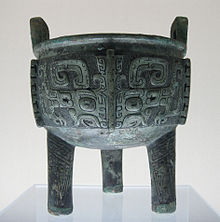
A
ding
from the late
Shang Dynasty
.
Tripod pottery have been part of the archaeological assemblage in China since
the earliest Neolithic cultures of
Cishan
and
Peiligang
in the 7th and 8th millennium BC.
Sacrificial tripods were also found in use in ancient
China
usually cast in bronze but sometimes
appearing in ceramic form. They are often referred to as “dings”
and usually have three legs, but in some usages have four legs.
The Chinese use sacrificial tripods in modern times, such as in 2005, when a
“National Unity Tripod” made of bronze was presented by the central Chinese
government to the government of northwest China’s
Xinjiang Uygur Autonomous Region
to mark its
fiftieth birthday. It was described as a traditional Chinese sacrificial vessel
symbolizing unity.
According to Herodotus (The Histories, I.144), the victory tripods were not
to be taken from the temple sanctuary precinct, but left there for dedication.

In
Greek
and
Roman mythology
, Apollo
,
is one of the most important and diverse of the
Olympian deities
. The ideal of the
kouros
(a
beardless youth), Apollo has been variously recognized as a god of light and the
sun; truth and prophecy;
archery
;
medicine and healing; music, poetry, and the arts; and more. Apollo is the son
of Zeus
and
Leto, and has a
twin
sister, the chaste huntress
Artemis
.
Apollo is known in Greek-influenced
Etruscan mythology
as Apulu. Apollo was worshiped in both
ancient Greek
and
Roman religion
, as well as in the modern
Greco
–Roman
Neopaganism
.
As the patron of Delphi
(Pythian Apollo), Apollo was an
oracular
god — the prophetic deity of the
Delphic Oracle
.
Medicine and healing were associated with Apollo, whether through the god
himself or mediated through his son
Asclepius
,
yet Apollo was also seen as a god who could bring ill-health and deadly
plague
as well as one who had the ability to cure. Amongst the god’s
custodial charges, Apollo became associated with dominion over
colonists
, and as the patron defender of herds and flocks. As the leader of
the Muses
(Apollon
Musagetes) and director of their choir, Apollo functioned as the patron god
of music and poetry
.
Hermes
created
the lyre
for him,
and the instrument became a common
attribute
of Apollo. Hymns sung to Apollo were called
paeans
.
In Hellenistic times, especially during the third century BCE, as Apollo
Helios he became identified among Greeks with
Helios
,
god of
the sun
, and his sister Artemis similarly equated with
Selene
,
goddess
of the moon
.
In Latin texts, on the other hand, Joseph Fontenrose declared himself unable to
find any conflation of Apollo with
Sol
among the
Augustan poets
of the first century, not even in the conjurations of
Aeneas
and
Latinus
in
Aeneid
XII
(161–215).
Apollo and Helios/Sol remained separate beings in literary and mythological
texts until the third century CE.
Lentini (Sicilian:
Lintini, historically: Leontinoi, Leontini
and Leontium) is a town and
comune
in the Province of Syracuse
, southeast
Sicily
(southern
Italy).
History
The ancient city was founded as Leontini (Greek:
Λεοντῖνοι) by colonists from
Naxos
in 729 BC, itself a
Chalcidian
colony
established five years earlier.
It is virtually the only
Greek
settlement in Sicily not located on the
coast, being some 6 miles inland. The site, originally held by the
Sicels,
was seized by the Greeks owing to its command of the fertile plain to the north.
The city was reduced to subject status in 498 BC by
Hippocrates of Gela
, who made his ally
Aenesidemus
its tyrant. In 476 BC
Hieron of Syracuse
moved the inhabitants from
Catana
and Naxos to Leontini.
Later on, the city of Leontini regained its independence. However, as part of
the inhabitants’ efforts to retain that independence, they sought the
intervention of Athens
. It was mainly the eloquence of
Gorgias
of Leontini which led to the abortive Athenian expedition of 427 BC.
In 422 BC Syracuse supported the oligarchs against the people and received
the oligarchs as citizens, the city of Leontini itself being forsaken. This led
to renewed Athenian intervention, at first mainly diplomatic; but the exiles of
Leontini joined the envoys of Segesta
, in persuading Athens to undertake the
great Sicilian Expedition
of 415 BC.
After the failure of the Expedition, Leontini became subject to Syracuse once
more. The city’s independence was guaranteed by the treaty of 405 BC between
Dionysius
and the
Carthaginians
, but lost again shortly after.
The city was finally stormed by
Marcus Claudius Marcellus
in 214 BC.
By Roman times it seems to have been of little importance. It was destroyed
by the
Saracens
in 848 AD, and almost totally ruined
by the
earthquake of 1693
. From the earthquake to
about the middle of the 20th century, Lentini was regarded by travel writers as
a malarial stop-over to Syracuse of minor historical importance.
The ancient city is described by
Polybius
as lying in a valley between two hills, and facing north. On the western side of
this valley ran a river with a row of houses on its western bank under the hill.
At each end was a gate, the northern gate leading to the plain, the southern, at
the upper end, leading to Syracuse. There was an acropolis on each side of the
valley, lying between precipitous hills with flat tops, over which buildings had
extended. The eastern hill still has the remains of a strongly fortified
medieval castle, in which some writers are inclined (though wrongly) to
recognize portions of Greek masonry.
Excavations were made in 1899 in one of the ravines in a Sicel necropolis of
the third period—explorations in the various Greek cemeteries resulted in the
discovery of some fine bronzes, notably a fine bronze lebes, now in the Berlin
museum.
Main sights
Lentini’s main monuments include:
- The Baroque
Chiesa Madre Santa Maria la Cava
e Sant’Alfio (“Mother Church of St. Mary of the Pit and St. Alphius”),
built in 1693 by Vella da Malta. It has a basilica plan with a nave and two
aisles; the three-orders façade is from the 18th century. Noteworthy is the
central portal with scenes of the martyrdoms of St. Alfio, Filadelphus and
Cirinus. The interior houses a Byzantine icon from the 12th century.
- The church of the Santissima Trinità and San Marziano. It was
built over the 16th century Palazzo La Palumba. It has a noteworthy pavement
in
ceramics
of
Caltagirone (18th century), a polyptych of
Antonello da Messina
‘s school and the high
altar tabernacle in
lapislazuli
.
- Church of the Immacolata (17th century). The interior is home to
a
Romanesque
lion sculpture, a Christ at
the Column and the tombstone of Queen Marie (1402).
- The Church of St. Luke. It has a notable San Francis Speaking by
Jacopo Bassano and other artworks. Next to the church are the
remains of the Castle of
Frederick II
, the
hypogeum of
St. Lucy
with 14th century frescoes, the
Crucifix Grottoes with frescoes from the 12th-17th centuries and the ruins
of the old parish church of St. Peter (16th century).
- The 18th century church of San Francesco di Paola, with a rare
organ
and artworks from churches destroyed
by the 1693 earthquake.
|











